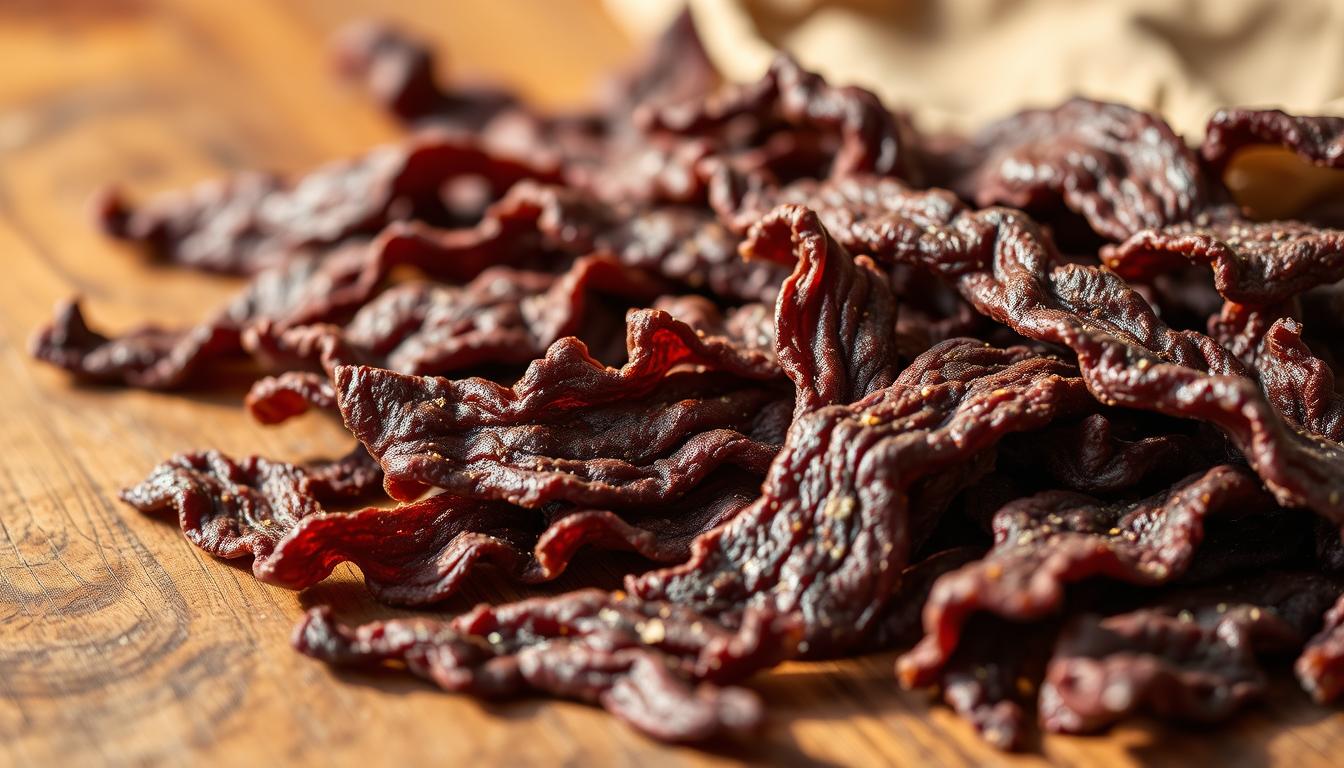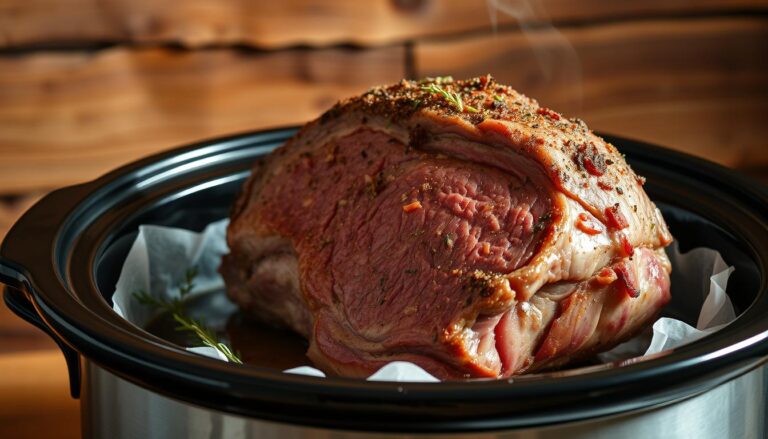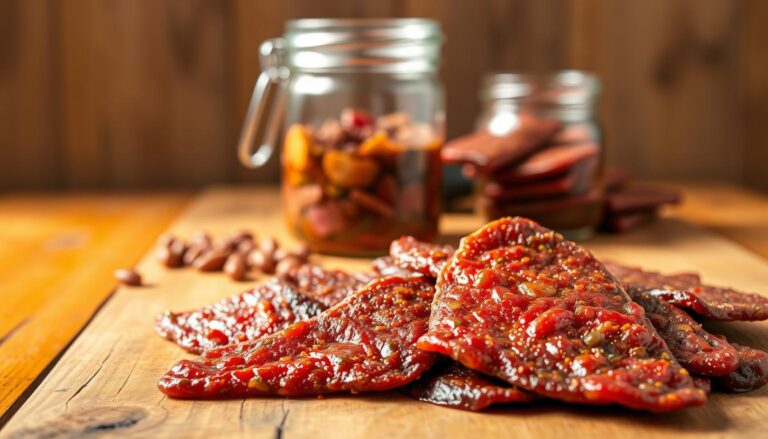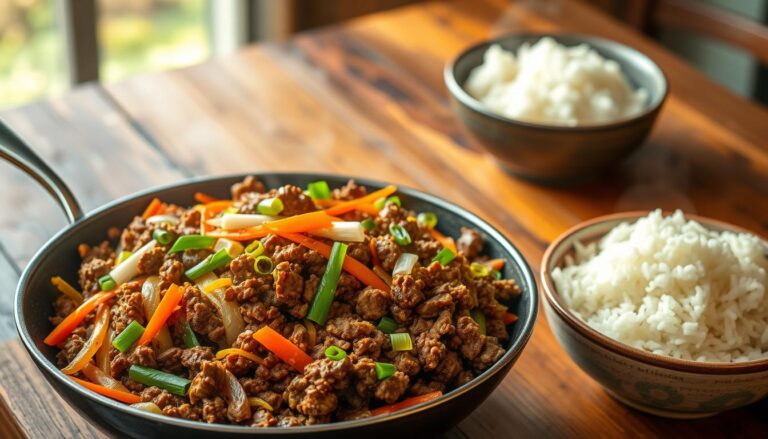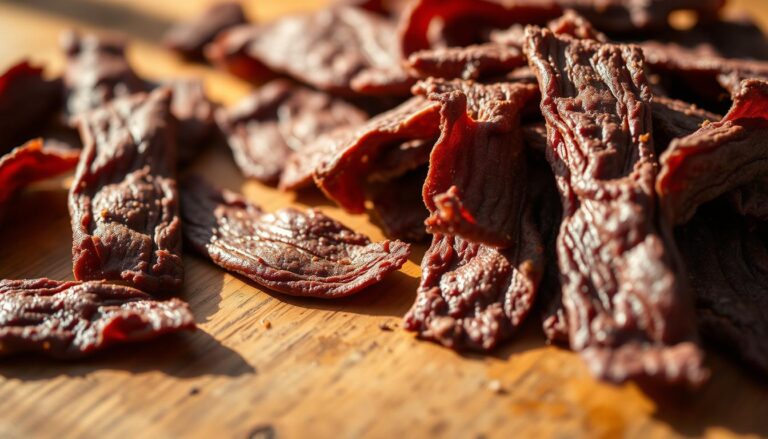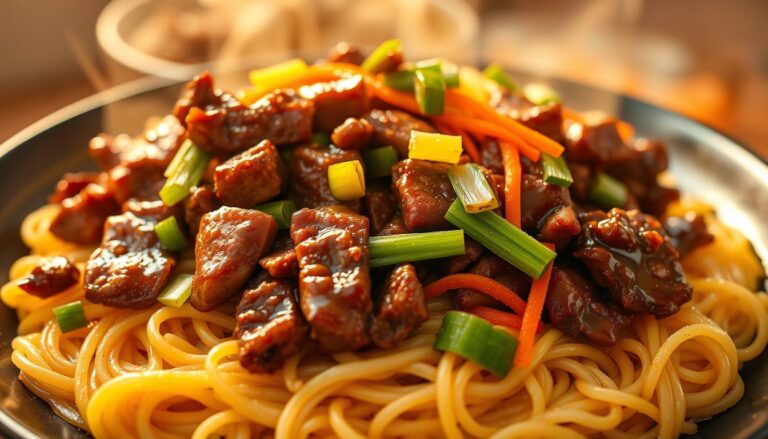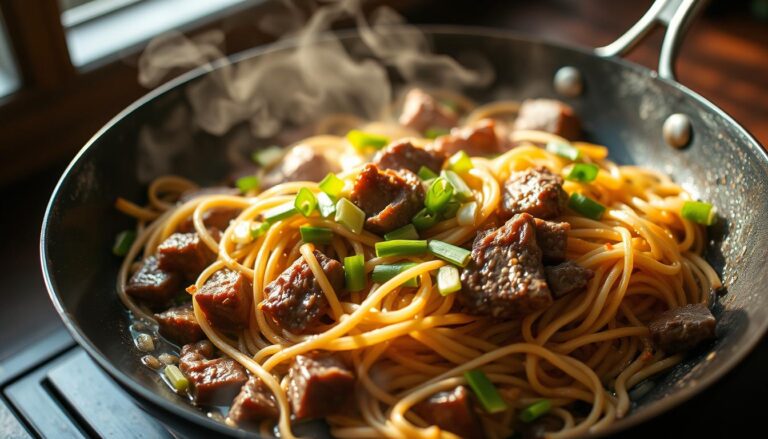Ground beef jerky: tips, tools, and drying times explained
Table of Contents
Are you searching for a snack that’s both healthy and full of flavor? Making your own ground beef jerky at home is the answer. It’s loved by outdoor fans and health buffs for its protein and ease of making.
With the right tips, you can whip up a tasty hamburger jerky recipe for quick snacks. This article will guide you through the essentials to make perfect ground beef jerky every time.
Key Takeaways
- Learn how to make ground beef jerky at home with ease.
- Discover the best tools for drying jerky to perfection.
- Understand the importance of drying times for safe consumption.
- Get tips on customizing your jerky to your favorite flavors.
- Find out how to store your homemade jerky for maximum freshness.
What is Ground Beef Jerky?
Ground beef jerky is a dried meat snack made from ground beef. It has a unique texture and flavor. You can add different seasonings and spices to make it your own.
Ground beef jerky is more uniform in texture and can be cheaper than traditional jerky. It’s also a good way to use leftover ground beef, helping to reduce waste.
Benefits of Making Jerky with Ground Beef
Making jerky with ground beef has many benefits. It offers a consistent texture that some people prefer over traditional jerky. You can also try out different flavors by seasoning it in various ways.
The process of making ground beef jerky is simple. You mix ground beef with seasonings, shape it, and then dry it. This makes it easy to create unique flavors.
Ground Beef vs. Whole Muscle Jerky
Ground beef jerky and whole muscle jerky differ in texture and flavor. Whole muscle jerky is chewy and has a natural beef taste. Ground beef jerky is uniform in texture and can be seasoned more heavily.
| Characteristics | Ground Beef Jerky | Whole Muscle Jerky |
|---|---|---|
| Texture | Uniform, can be tender or slightly firm | Chewy, fibrous |
| Flavor | Can be highly seasoned, uniform flavor | More natural beef flavor, can be less uniform |
| Cost | Can be cost-effective, uses ground beef | Generally more expensive due to the cut of meat |
Choosing between ground beef jerky and whole muscle jerky depends on your taste. You might like one better than the other, or enjoy them for different times.
Essential Ingredients for Perfect Ground Beef Jerky
Making perfect ground beef jerky begins with picking the right ingredients. The quality and type of ingredients greatly affect the flavor, texture, and quality of your jerky.
Selecting the Right Ground Beef
The type of ground beef you choose is key. Go for lean ground beef with about 90% lean or more. This keeps the jerky from getting too greasy or spoiling. You can pick chuck, round, or sirloin based on your taste and texture preference.
Necessary Curing Agents
Curing agents are important for keeping your jerky fresh and preventing bacteria. Salt is a main curing agent that adds flavor and helps dry the meat. You might also use nitrates or nitrites to improve preservation and color, like in commercial jerky.
Flavor Enhancers and Preservatives
To flavor your jerky, try different spices, marinades, and seasonings. Garlic powder, onion powder, and paprika are popular choices. You can also add liquid smoke or Worcestershire sauce for more depth. Here’s a list of common flavor enhancers:
- Garlic powder
- Onion powder
- Paprika
- Chili powder
- Black pepper
Tools and Equipment You’ll Need
Having the right tools is key to making tasty ground beef jerky. You’ll need some essential equipment to prepare and dry your jerky perfectly.
Jerky Guns and Extruders
A jerky gun or extruder is a must-have for making uniform strips. These tools help shape your ground beef into consistent shapes. You can pick between manual or electric jerky guns, based on what you like and can afford.
Dehydrators and Ovens
A dehydrator is the top choice for drying jerky, as it controls the drying process. If you don’t have a dehydrator, your oven on the lowest setting works too. Some ovens even have a dehydrate function, which is super handy.
Additional Helpful Tools
Other useful tools for making jerky include mixing bowls, spatulas, and baking sheets lined with parchment. A meat thermometer is also handy to check the jerky’s internal temperature.
| Tool/Equipment | Purpose | Essential? |
|---|---|---|
| Jerky Gun/Extruder | Shapes ground beef into uniform strips | Yes |
| Dehydrator | Dries jerky evenly | Yes |
| Oven | Alternative for drying jerky | No |
| Mixing Bowls & Spatulas | Mixes and handles ground beef mixture | Yes |
| Meat Thermometer | Ensures safe internal temperature | No |
Preparing Your Ground Beef for Jerky
Getting your ground beef ready for jerky is a key step. It affects the jerky’s texture, taste, and success. How well you prepare the meat before drying is very important.
Grinding Your Own vs. Store-Bought
First, you must decide if you’ll grind your own beef or buy it. Grinding your own gives you control over fat and texture. But, it takes more work and the right tools. Store-bought is easy but might have additives or less ideal fat for jerky.
Fat Content Considerations
The fat in your beef is key for jerky’s texture and taste. Leaner meat (90% lean or higher) is best for a chewier texture and less spoilage risk. But, some fat is needed for flavor, so finding a balance is important.
Mixing Techniques for Optimal Texture
Mixing your beef with curing agents and flavor enhancers is vital. You need to mix well but gently to avoid making the meat tough. The goal is to spread the ingredients evenly without changing the meat’s natural feel.
| Mixing Technique | Effect on Jerky |
|---|---|
| Gentle Fold | Preserves texture, ensures even distribution of ingredients |
| Overmixing | Results in tough or dense jerky |
| Minimal Mixing | May lead to uneven flavor distribution |
Popular Ground Beef Jerky Recipes
Ground beef jerky recipes have it all, from classic to creative flavors. You can try out different ingredients and spices to make jerky that you love. It’s all about finding the perfect taste for you.
Classic Hamburger Jerky Recipe
A hamburger jerky recipe is perfect for beginners. It mixes ground beef with simple spices like salt, pepper, and garlic powder. Then, it’s dried to perfection. Here’s what you need:
- 1 lb ground beef
- 1 tablespoon salt
- 1 teaspoon black pepper
- 1 teaspoon garlic powder
Just mix everything well and shape it into thin strips. Then, dry it as instructed.
Spicy Minced Beef Jerky Variation
If you like a little heat, try the spicy minced beef jerky version. It adds chili flakes or hot sauce for a spicy taste. To make it, add:
- 1-2 teaspoons chili flakes or hot sauce to the classic hamburger jerky mixture
This gives the jerky a bold, spicy flavor that’s perfect for spice lovers.
Sweet and Savory Beef Jerky Recipe Ground Beef Style
The sweet and savory beef jerky recipe is a delightful mix of flavors. It adds brown sugar or honey to balance out the salt. To make it, mix in:
- 1 tablespoon brown sugar or honey into the classic hamburger jerky mixture
This creates a jerky that’s both sweet and savory. It’s great for those who enjoy complex flavors.
These recipes are just the beginning. Don’t be afraid to try new seasonings and ingredients. You can make your own beef jerky recipe ground beef style.
Forming and Shaping Techniques
Shaping your ground beef jerky into uniform strips or sticks is key for even drying. The way you shape it affects its texture and quality.
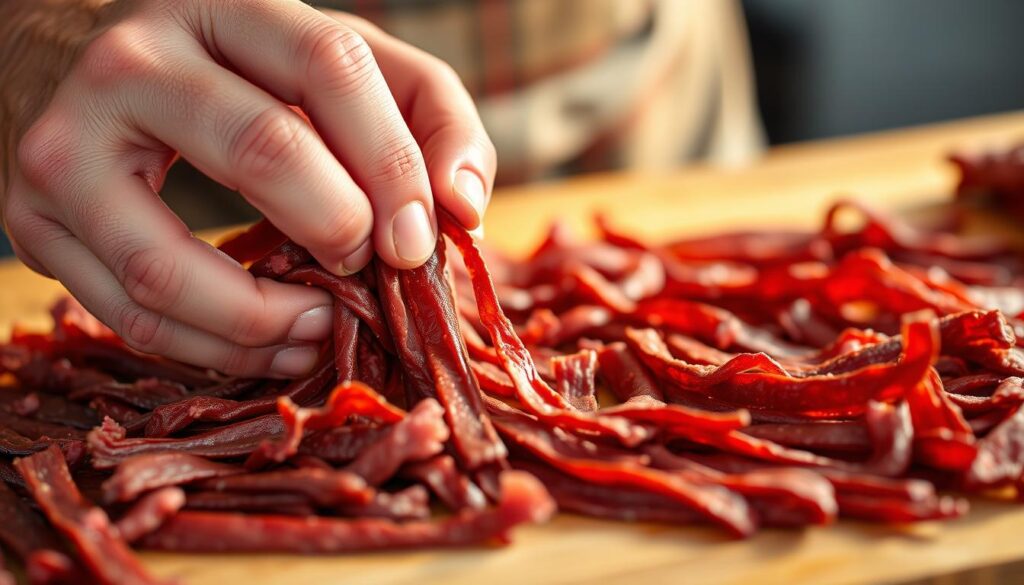
Using a Jerky Gun Effectively
A jerky gun helps make uniform strips of ground beef jerky. Fill it just right, not too much. Hold it steady and squeeze out the mixture slowly. This ensures even thickness and length.
Creating Strips, Sticks, and Shapes
You can make different shapes with your ground beef jerky. Strips are common, but you can also make sticks or shapes with a cookie cutter. Use a jerky gun or piping bag for strips, or shape by hand for sticks.
Thickness Guidelines for Even Drying
Even thickness is important for drying. Aim for about 1/4 inch (6 mm) thickness. Adjust your jerky gun or keep it even by hand.
Drying Times Explained for Ground Beef Jerky
To get your ground beef jerky just right, you need to know about drying methods. The drying process is key for the right texture and safety. We’ll look at dehydrator, oven drying, and how to check if it’s done.
Dehydrator Method: Temperature and Timing Charts
Dehydrators are popular for drying jerky because they control temperature well. Set your dehydrator to 135°F to 155°F. The drying time depends on the jerky’s thickness and how dry you like it.
| Thickness | Temperature | Drying Time |
|---|---|---|
| 1/4 inch | 145°F | 3-4 hours |
| 1/2 inch | 145°F | 6-8 hours |
Thicker strips take longer to dry. Always check your jerky to avoid over-drying.
Oven Drying: Temperature Settings and Duration
Without a dehydrator, your oven can work well. Preheat it to its lowest setting, about 150°F to 200°F. Put the jerky on a baking sheet with parchment paper. Leave the oven door a bit open to let moisture out.
Oven drying takes 3 to 6 hours, based on temperature and thickness. Keep an eye on the jerky’s texture to adjust drying time.
How to Test for Proper Doneness
Testing is key, no matter the drying method. Good jerky is flexible but not sticky. If it’s too dry, it breaks easily. To test, take a piece out and let it cool. If it’s too moist, dry it a bit more.
“The key to great jerky is achieving the perfect balance between dryness and flexibility. It’s a process that requires patience, but the result is well worth the effort.”
By following these tips and choosing the right method, you can make delicious ground beef jerky for snacking on the go.
Troubleshooting Common Ground Beef Jerky Problems
Making ground beef jerky can be tricky. But knowing the common problems helps you avoid them. This way, you can make delicious jerky every time.
Too Dry or Too Moist: Finding the Balance
Getting the right moisture is key for good jerky. If it’s too dry, it’s hard and not tasty. Too moist, and it’s not safe to keep.
To get it just right, play with the drying time and temperature. For example, if using a dehydrator, try lowering the temperature by 5 degrees. Then, increase the drying time a bit.
- Check the jerky’s texture often while it dries.
- Use a food thermometer to make sure it’s safe.
- Think about your area’s humidity when setting drying times.
Dealing with Uneven Drying
Uneven drying can make some jerky too cooked and others not enough. To fix this, make sure all strips are uniform in thickness. You can use a jerky gun or shape them by hand carefully.
- Use a jerky gun for even strips.
- Turn the strips halfway through drying.
- Make sure air can move freely around the jerky.
Preventing Crumbling and Breakage
To stop jerky from crumbling or breaking, handle it gently and store it right. Let it cool down completely before putting it in a sealed container.
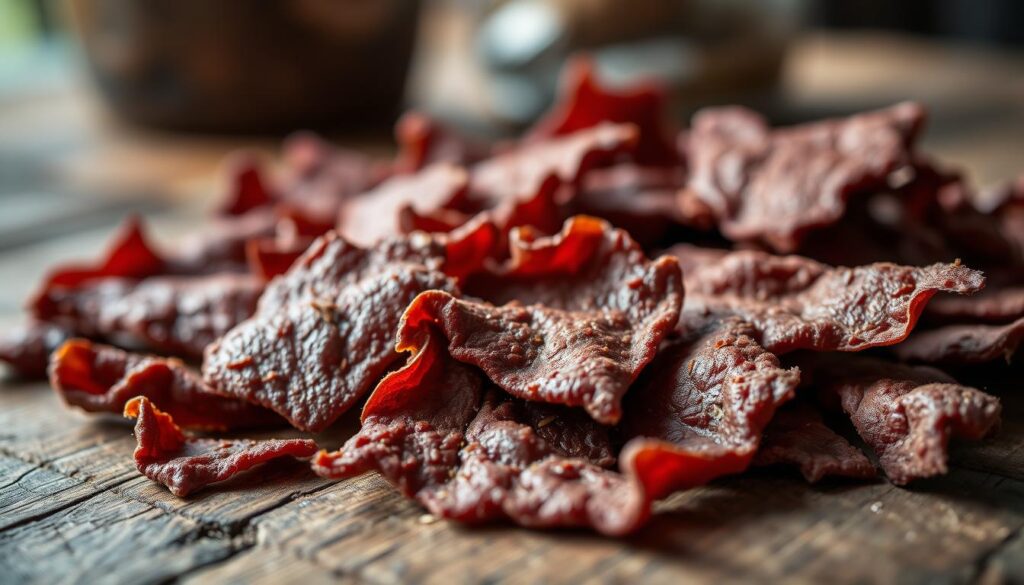
- Be careful when handling the jerky.
- Store it in a sealed container to keep it fresh.
- Keep it away from sunlight and moisture.
Conclusion: Storing and Enjoying Your Homemade Ground Beef Jerky
Now that you’ve made ground beef jerky, it’s time to store and enjoy it. Keeping it fresh is key. Proper storage helps maintain the jerky’s texture and taste.
Use airtight containers to store your jerky. Glass jars or resealable plastic bags work well. Make sure to remove air before sealing. Also, keep it away from sunlight and heat to preserve quality.
You can snack on it alone or add it to meals. Try it in salads, wraps, or pasta dishes for extra protein. It’s also great on baked potatoes or in soups and stews.
Don’t be afraid to try new flavors and recipes. Mixing up your beef jerky recipe with different seasonings or marinades is fun. Homemade ground beef jerky is versatile and convenient for snacking on the go.

